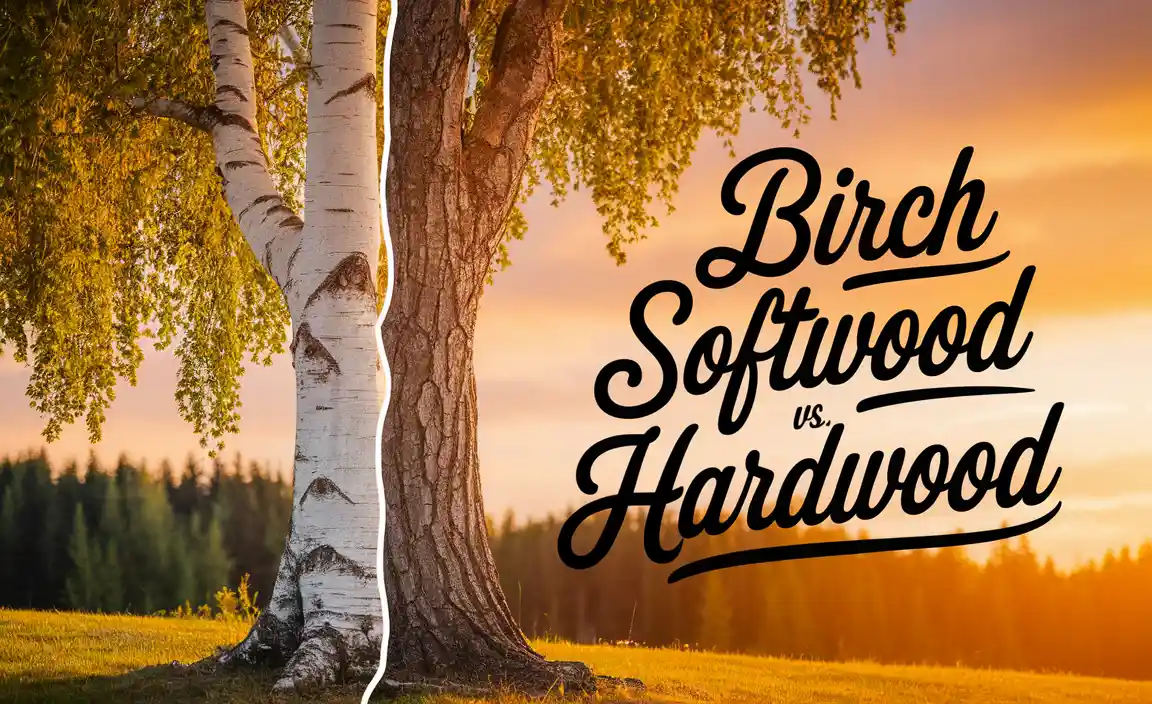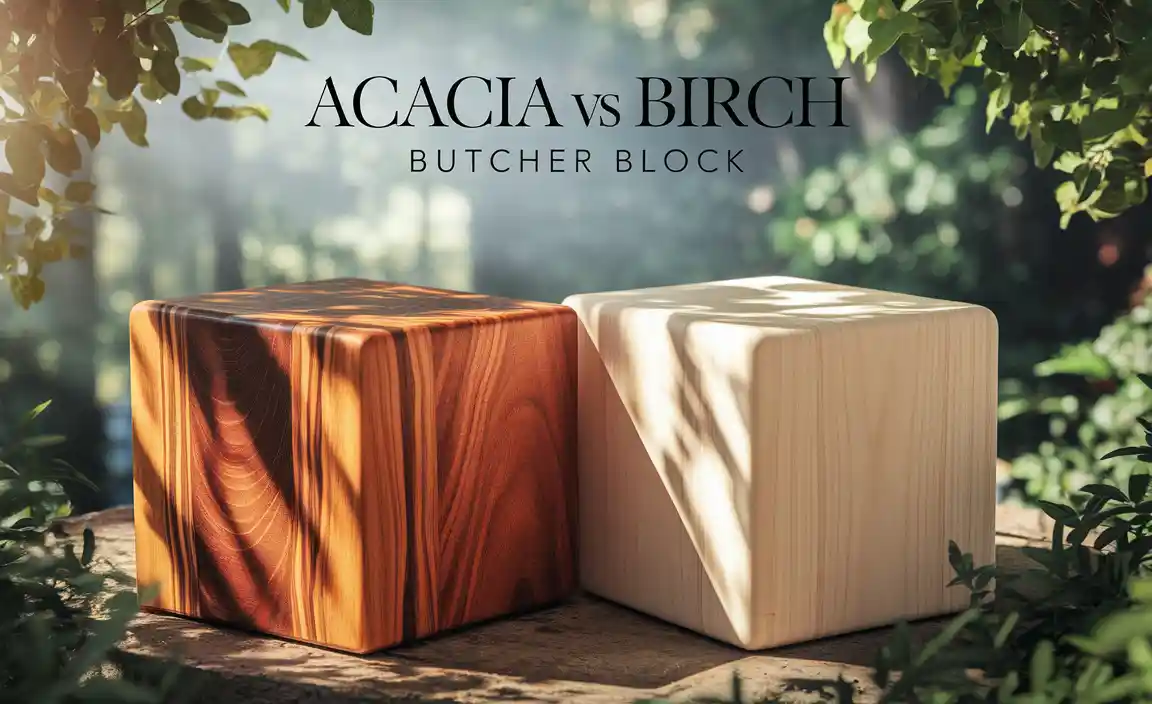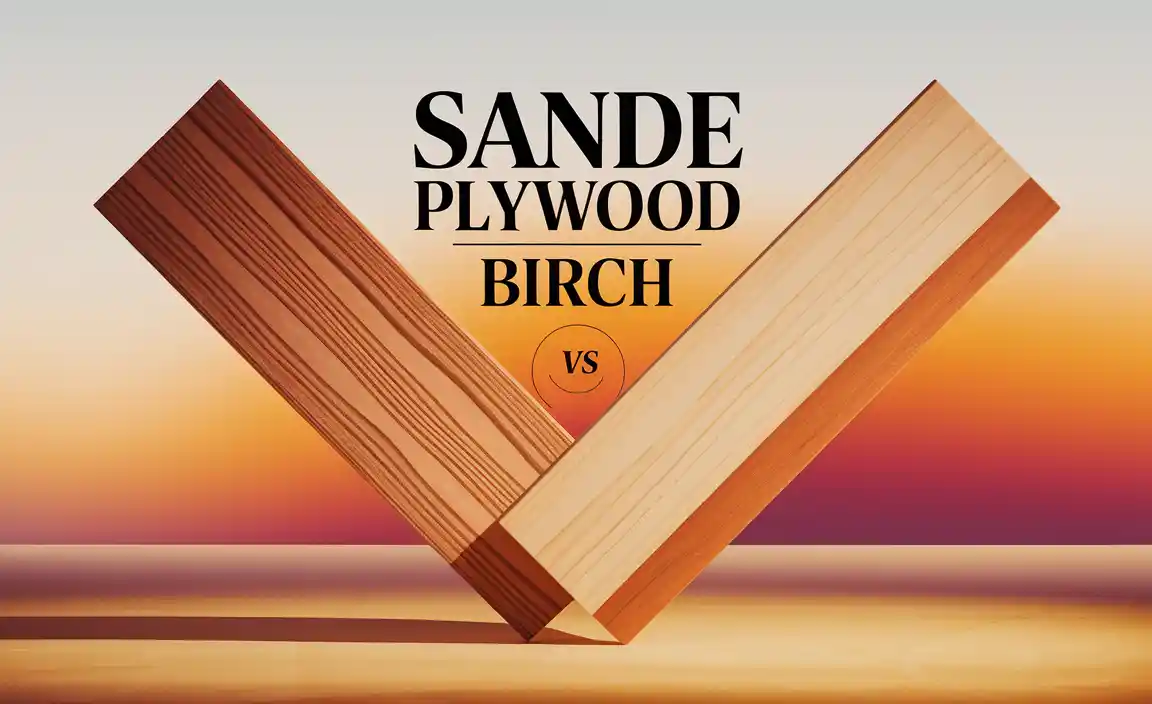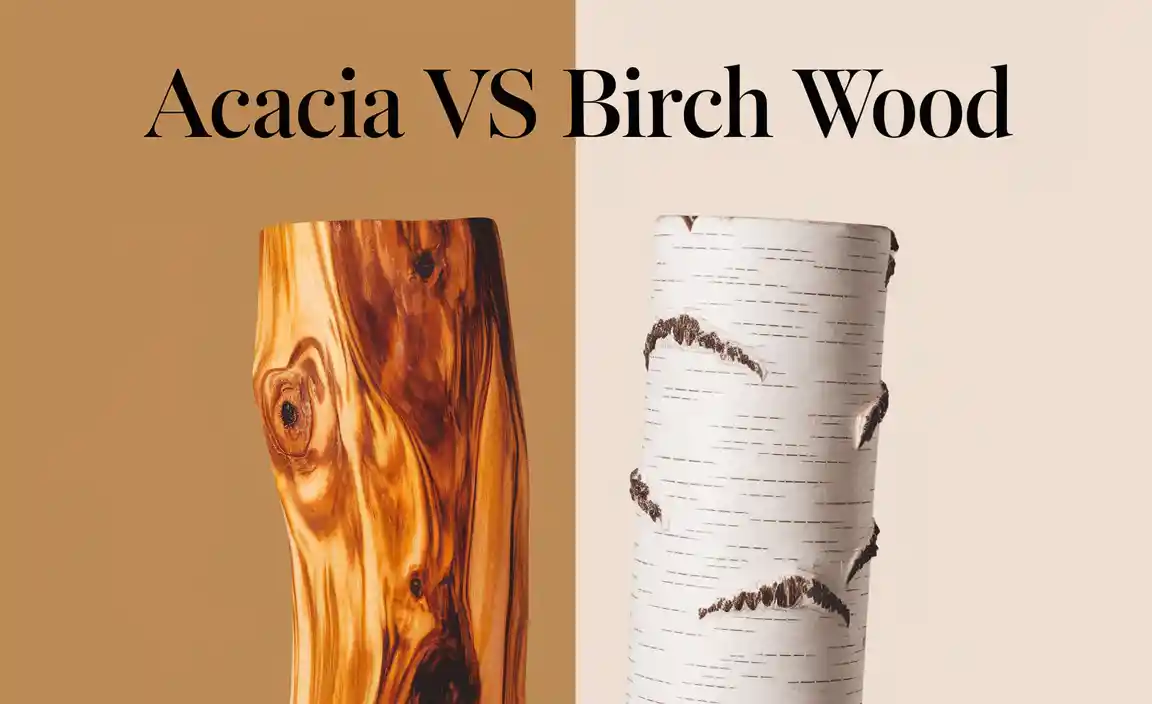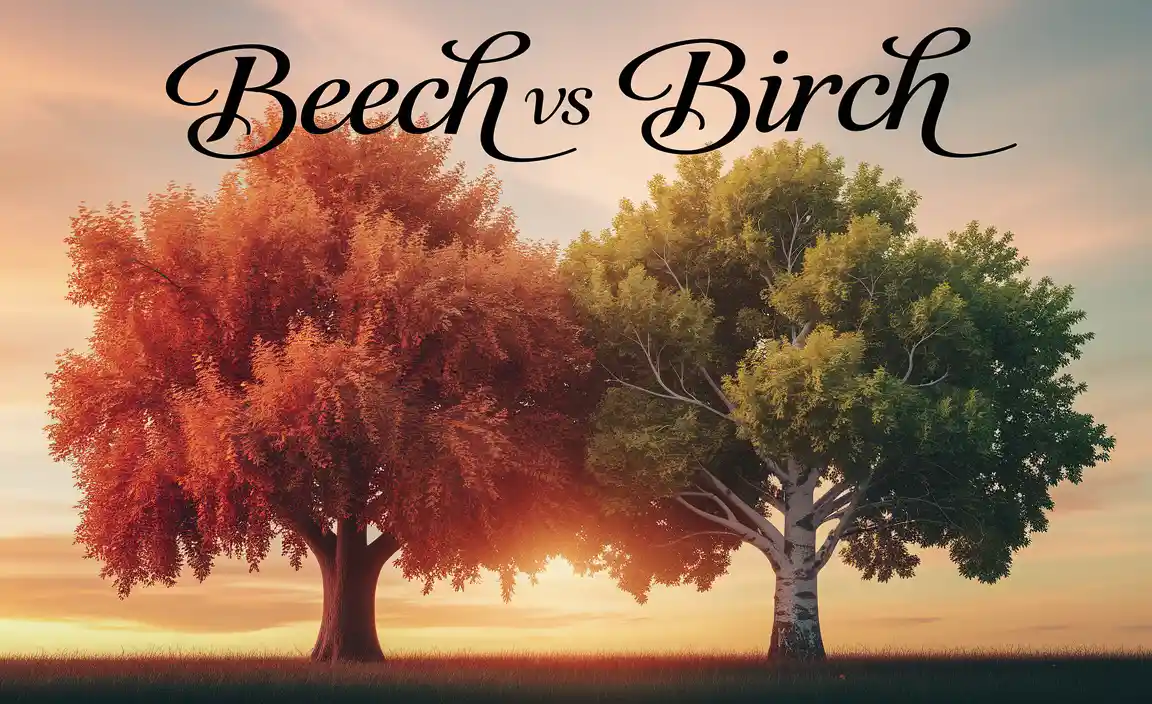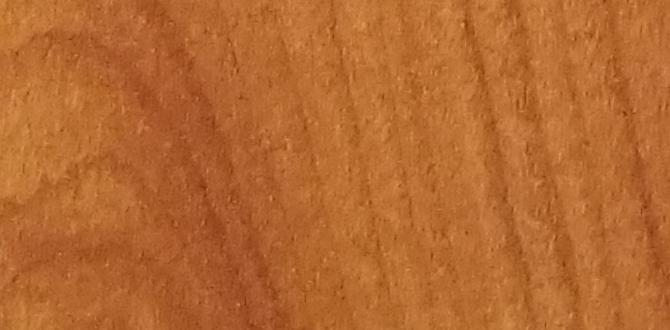Have you ever wondered what makes plywood so special? In the world of woodworking, birch and maple plywood stand out. Each type has unique qualities that can change the way you create.
Imagine you want to build a treehouse. Do you know which plywood to choose? Birch plywood is often smooth and bright. It’s great for projects where a clean look matters. On the other hand, maple plywood has a lovely, warm tone and strong grain. It can add charm to furniture or crafts.
Did you know that birch trees grow quickly? They are common in many places. Maple trees, however, take longer to mature but offer beautiful colors. These trees give life to the plywood you see in stores. Choosing between birch and maple can feel tricky, but it’s an exciting journey.
Let’s dive deeper into the differences. Understanding birch vs maple plywood will help you make the best choice for your next project!
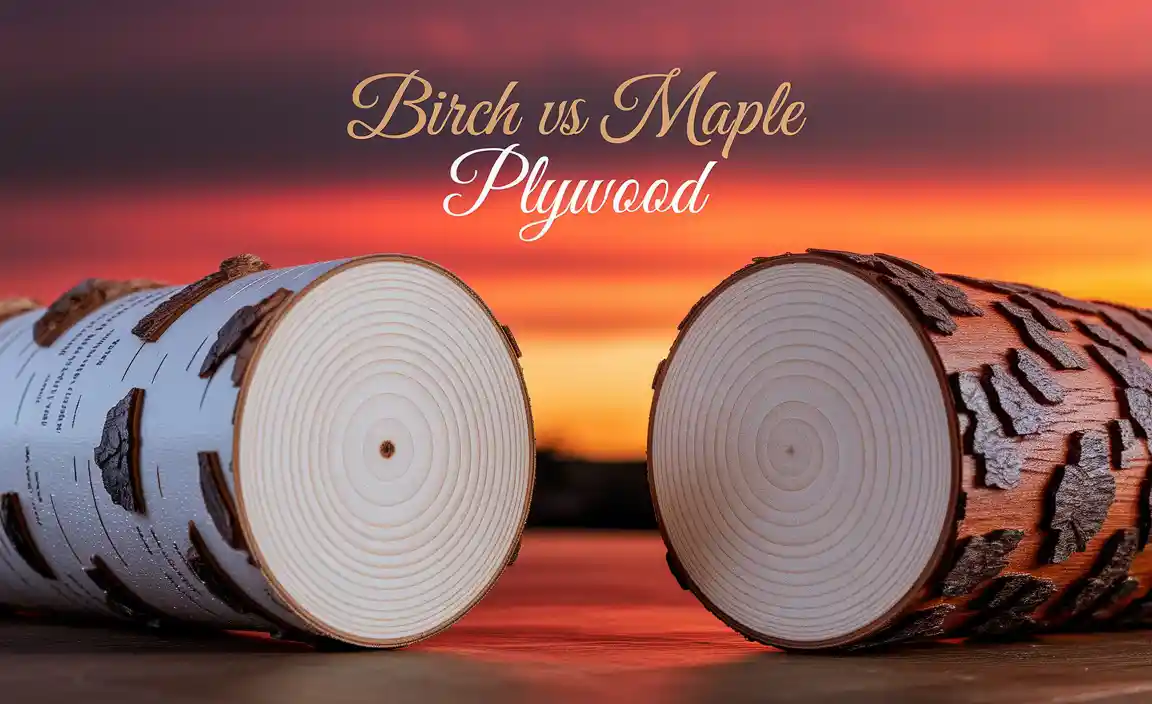
Table of Contents
Birch Vs Maple Plywood: Comparing Two Popular Choices Birch And Maple Plywood Are Two Of The Most Sought-After Materials In Woodworking And Furniture Making. Each Type Of Plywood Has Its Unique Characteristics, Benefits, And Drawbacks That Make Them Suitable For Different Applications. In This Article, We Will Explore The Differences And Similarities Between Birch And Maple Plywood, Helping You Make An Informed Decision For Your Next Project. Understanding Birch Plywood Birch Plywood Is Known For Its Fine Grain And Light Color, Which Can Range From Creamy White To Pale Yellow. The Plywood Is Often Used In Cabinetry, Furniture, And Interior Applications Due To Its Aesthetic Appeal And Strength. Birch Is A Hardwood, Making It Durable And Resistant To Wear And Tear. It Also Has Excellent Machining Properties, Allowing For Clean Cuts And Easy Finishing. Characteristics Of Maple Plywood Maple Plywood, On The Other Hand, Is Recognized For Its Hardness, Density, And Resistance To Shock. It Typically Has A Slightly Warmer Tone Than Birch, Featuring A Range Of Hues From Light Tan To Reddish-Brown. Maple Plywood Is Favored In Applications Requiring Resilience, Such As Flooring And Heavy-Use Furniture. Its Tight, Uniform Grain Pattern Provides A Smooth Surface, Making It An Excellent Choice For Staining And Finishing. Key Differences Between Birch And Maple Plywood 1. **Color And Grain** Birch Generally Has A Lighter, More Uniform Color, While Maple Tends To Have A Richer, More Varied Tone With Prominent Grain Patterns. 2. **Hardness And Durability** Maple Plywood Is Harder And More Durable Than Birch Plywood, Which May Affect Its Suitability For Different Applications. 3. **Cost** Generally, Birch Plywood May Be Less Expensive Compared To Maple Plywood, Which Could Be A Significant Factor In Larger Projects. 4. **Finishing** Both Plywood Types Take Stain And Finishes Well, But The Distinct Characteristics Of Each Material Can Result In Different Final Appearances. Conclusion When Comparing Birch Vs Maple Plywood, It Ultimately Comes Down To Your Specific Project Needs And Aesthetic Preferences. Birch May Be The Way To Go If You’Re Looking For A Lighter, More Affordable Option. However, If You Require A Harder, More Durable Material That Can Withstand Heavy Use, Maple Could Be The Preferred Choice. Evaluate Your Options Carefully To Ensure You Select The Right Plywood For Your Next Woodworking Project.

Birch vs Maple Plywood
Birch and maple plywood are popular choices for furniture and crafts. Birch plywood is known for its fine grain and smooth surface, making it easy to paint or stain. Maple plywood, on the other hand, has a slightly warmer color and a little more strength. Which one is better for your project? It depends on your needs. Did you know that wood from birch trees helps in sound insulation? Choosing between birch and maple can influence durability and aesthetics in your work.
Understanding Birch Plywood
Definition and characteristics of birch plywood. Common uses and applications in various industries.
Birch plywood is a strong and versatile material made from thin layers of birch wood glued together. It has a smooth surface and a light color. This makes it great for many uses. Birch plywood is often used in furniture, cabinets, and flooring. It is known for its durability and resistance to wear. Here are some key points:
- Strength: Birch plywood can handle heavy loads.
- Appearance: It has a beautiful, even grain.
- Workability: It’s easy to cut and shape.
This makes it a favorite among builders and designers.
What is birch plywood commonly used for?
Birch plywood is commonly used for furniture, cabinetry, and interior design projects. Its strength and beauty make it a popular choice for DIY projects as well.
Understanding Maple Plywood
Definition and characteristics of maple plywood. Common uses and applications in various industries.
Maple plywood is strong and sturdy. It comes from the hard maple tree, known for its fine grain and light color. This wood is smooth, making it perfect for many projects. People love using maple plywood for furniture, cabinets, and flooring. It’s like the superhero of wood! With a durability that can withstand daily use, it’s also eco-friendly. Whether you are crafting a simple shelf or building a fancy kitchen, maple plywood gets the job done with style.
| Characteristics | Common Uses |
|---|---|
| Strong and durable | Furniture |
| Smooth surface | Cabinets |
| Light color | Flooring |
Key Differences Between Birch and Maple Plywood
Comparison of structural properties. Differences in appearance and grain patterns.
Birch and maple plywood each have unique features. Birch plywood is known for its strength and stability. It can support heavy loads. Maple plywood, on the other hand, is tough and flexible, making it ideal for furniture.
In terms of looks:
- Birch has a pale, creamy color.
- Maple is often slightly darker with rich, warm tones.
- Birch grain patterns are fine and even.
- Maple features darker streaks that create a unique design.
These differences can affect your choice based on what you need. Consider the look and function when choosing which plywood to use.
What are the main uses of birch and maple plywood?
Birch plywood is great for cabinets and drawers. Maple plywood works well for furniture and decorative items.
Durability and Strength: Birch vs Maple
Analyzing the strengthtoweight ratio. Resistance to wear and tear in different environments.
When we compare birch and maple plywood, we notice some big differences in strength and durability. Birch plywood is known for its high strength-to-weight ratio. This means it is strong but still light. Maple plywood is also strong but can be a bit heavier.
Both types resist wear and tear, but they perform differently in various environments. Birch does well in humid places, while maple is great in dry spots. Here’s a quick comparison:
- Strength-to-Weight Ratio: Birch is lighter and strong.
- Wear and Tear Resistance: Birch suits humid areas; maple shines in dry ones.
Choosing the right plywood depends on where and how you will use it. Think about your project’s needs carefully!
How strong is birch plywood?
Birch plywood is very strong and lightweight, making it great for furniture and crafts.
How does maple plywood compare?
Maple plywood is strong but a bit heavier, perfect for flooring and cabinets.
Cost Considerations: Birch vs Maple Plywood
Price comparison of birch and maple plywood. Factors influencing the cost of each type.
Choosing between birch and maple plywood? Let’s break it down! Birch plywood usually costs less than maple. Why? Birch trees grow faster, making them more available. On the other hand, maple plywood is often pricier due to the slower growth of maple trees and its dense, strong quality.
Factors like quality, thickness, and brand will also affect prices. So, keep an eye out for sales—you might snag a good deal! Remember, whether it’s birch or maple, both can build great projects! Just don’t get lost in the wood shop!
| Type | Average Cost per Sheet |
|---|---|
| Birch Plywood | $30 – $60 |
| Maple Plywood | $50 – $100 |
Environmental Impact and Sustainability
Sourcing and sustainability of birch plywood. Sourcing and sustainability of maple plywood.
Choosing between birch and maple plywood? Let’s talk about Mother Nature! Birch plywood often comes from sustainable forests in Europe. This helps keep our planet happy and healthy. Maple plywood, on the other hand, is usually sourced from North America. It’s also sustainable, preserving habitats where critters call home. Sustainability is key! We must ensure that our choices don’t leave trees crying in the forest. So, choose wisely, and let’s save the trees! 🌳
| Type of Plywood | Sourcing | Environmental Impact |
|---|---|---|
| Birch | From sustainable forests in Europe | Promotes healthy ecosystems |
| Maple | From North American forests | Supports native wildlife |
Best Practices for Working with Birch and Maple Plywood
Recommended tools and techniques for cutting and finishing. Tips for maintenance and care of plywood products.
Using birch and maple plywood can be a lot of fun! For cutting, a fine-tooth saw works best. It gives a smooth edge, which is always nice. Don’t forget to wear your safety goggles; you want to protect those peepers!
For finishing, a good sandpaper does wonders. Start with a coarse one, then move to a fine grit for that silky touch. Want to keep it looking great? Regular cleaning with a damp cloth helps. Make sure to avoid harsh chemicals; they’re like bad jokes—no one wants them!
| Task | Recommended Tool |
|---|---|
| Cutting | Fine-tooth saw |
| Sanding | Coarse to fine sandpaper |
| Cleaning | Damp cloth |
Remember, proper care keeps your plywood looking fresh and fabulous! Like they say, “A clean workspace is a happy workspace!” Keep those boards shiny, and they’ll reward you with years of beauty and use.
Conclusion
In summary, Birch plywood is strong and smooth, perfect for fine furniture. Maple plywood offers a warm look and great durability. Both choices have unique benefits, so think about your project needs. You can explore more about their uses and features online. Choosing the right plywood can help make your creations even better! Happy building!
FAQs
Sure! Here Are Five Related Questions On The Topic Of Birch Vs. Maple Plywood:
Sure! Birch plywood is usually lighter in color and has a smooth surface. Maple plywood is a bit darker and has a nice grain pattern. Birch is often cheaper than maple. Both types are strong and good for furniture or crafts. You can choose based on your project needs!
Sure! Please provide me with the question you would like me to answer.
What Are The Key Differences In Strength And Durability Between Birch And Maple Plywood?
Birch plywood is usually stronger than maple plywood. It can take more weight without bending. Maple plywood is a bit softer, so it can dent more easily. Both types are durable, but birch is often the better choice for heavy use. You might want to use birch for things like furniture and maple for lighter projects.
How Do The Grain Patterns And Aesthetics Of Birch Plywood Compare To Those Of Maple Plywood?
Birch plywood has light, smooth grains that look very bright and clean. It often has a yellowish or creamy color. Maple plywood, on the other hand, has a tighter, wavy grain that gives it a different feel. Maple is usually a bit darker than birch. Both are beautiful, but they have different looks!
In Terms Of Cost, How Do Birch And Maple Plywood Stack Up Against Each Other?
Birch plywood usually costs a bit less than maple plywood. If you’re on a budget, birch might be a better choice for you. Maple plywood can be more expensive because it is often considered fancier. However, both are good options for projects, and the prices can change based on where you shop.
What Are The Best Applications For Birch Plywood Versus Maple Plywood In Furniture And Cabinetry?
Birch plywood is great for making strong furniture and cabinets that need to hold a lot. It has a smooth surface that looks nice when painted or stained. Maple plywood is better for pieces that need to look fancy, like dressers or shelves. It has a pretty grain pattern that shows off well. Choose birch for strength and maple for beauty!
How Do The Environmental Sustainability Practices Differ Between The Sourcing Of Birch And Maple Plywood?
When we get birch plywood, we often use trees grown in colder places. These trees grow fast, so they can be replaced quickly. Maple plywood comes from trees that take longer to grow. This means we need to be more careful and make sure we don’t cut down too many maple trees at once. Each type of wood has different rules to help keep our forests healthy.
